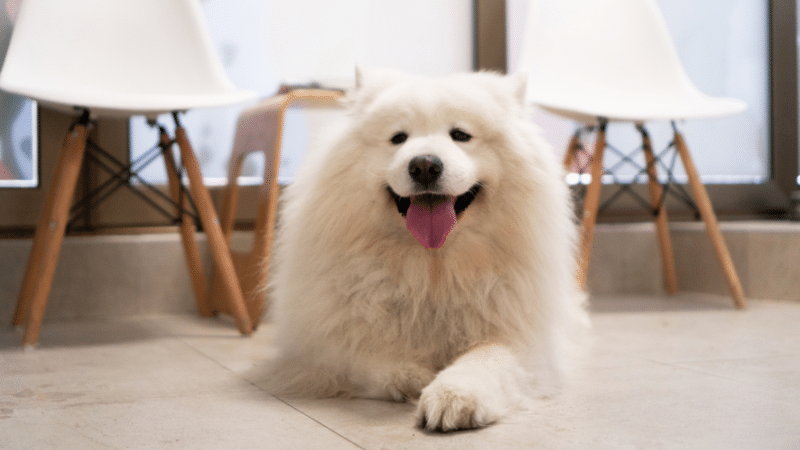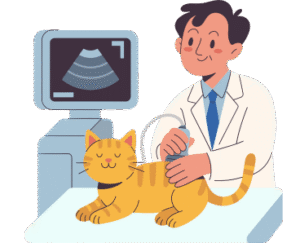The Samoyed dog (the name is pronounced suh-moy-uhd) is most widely known by their fur, which is fluffy and of a pure white color, their curly tail, gregarious nature, and their fondness for cold weather.
They are working dogs designed to operate in very cold conditions. The original purpose of these dogs was to herd reindeer and pull sleds belonging to the Samoyed people of northwestern Siberia, the Samoyed Club of America (SCA) stated. Samoyeds are so thickly furred due to their northern roots and have a very thick two-layer coat composed of a long, straight-haired top coat and a dense, fine undercoat.

This medium-to-large working breed stands 19 to 23.5 inches tall and weighs between 36 and 65 pounds. With a lifespan of 12 to 14 years, they are known for their friendly nature and active energy. They shed moderately and need regular grooming. As part of the working group, they’re strong, loyal, and thrive with daily exercise. Common health concerns include eye issues, heart problems, hip dysplasia, and kidney disorders. With proper care and regular vet checkups, they can live a healthy, active life.
Caring for a Samoyed Puppy
Being a playful, alert, and friendly dog, the temperament of a Samoyed can be the best companion for a lap of first-time pet owner who is willing to satisfy its high exercise and grooming demands as a working-type dog.
Samoyed dogs have to be brushed regularly, and they do not live well in hot environments. Pet owners are advised that a Samoyed is susceptible to heatstroke during hot weather and should watch their dog to see the indicators that it is getting overheated. With that said, Samoyeds prefer low temperatures and enjoy running around in the snow.
Samoyed is a working dog that is athletic and never grows tired. Sled pulling, herding, agility, and hunting are the main activities with which the dogs are mostly associated. They must be well exercised (at least two hours a day!) They are playful pups that enjoy the company of people and other dogs.
Samoyed Health Issues
When purchasing a Samoyed puppy, expect your furry family member to live a normal 12 – 14 years, which is the average life span of a medium-sized dog.
They may also acquire a couple of diseases in the span of their life, and their susceptibility to warmer weather may become the cause of other medical problems. Coverage of dog insurance can be an excellent investment for your Samoyed.
Retinal Diseases
On the back of the eye is the retina, the retina detects light and sends a message to the brain, which carries out a recognition of the image. Two retinal diseases are common in Samoyeds:
Retinal dysplasia: This is the occurrence whereby the retina has abnormal folds, which cause a decline in vision and ultimately blindness. Retinal dysplasia may be a genetic disorder in Samoyeds, and it can be detected using a dog DNA test.
Progressive retinal atrophy (PRA): Progressive retinal atrophy or PRA is a hereditary disease that causes the death of the light sensors or photoreceptors of the retina of young to middle-aged Samoyed dogs, causing them to go blind. PRA screening and genetic DNA testing are also available.
Uveodermatologic Syndrome (UDS)

UDS in dogs is a skin and eye disease in which a dog attacks the production of melanin by its own body.
It is melanin that determines the diversity of colors of pigments of the skin and hair, as well as some parts of the eye. UDS may lead to different skin lesions and skin lightening (depigmentation), inflammation of the eyes, and vision disorders.
The usual treatment of UDS employs steroids and/or cyclosporine as a way of suppressing the body’s immune system.
Heart Problems
Some of the heart problems that Samoyeds may be susceptible to are:
Atrial septal defect (ASD): A hole forms between the left and the right atria (upper chambers) of the heart since the time a baby is in the womb and closes before birth. However, in dogs with ASD, the hole remains throughout life and may result in abnormal blood flow and heart failure.
Aortic stenosis: This is when there is a constricted aperture of the aortic valve located in the heart, which occurs as the canine gets older. Nevertheless, although a heart murmur can be detected during a physical examination by a veterinarian, in most cases, this heterogeneity does not lead to any significant complications, and dogs suffering from the condition can live a normal life. Yet, in extreme cases of aortic stenosis, its clinical manifestations, like drowsiness, dyspnea, cough, or fainting, can be present.
Pulmonic stenosis: This is a congenital complication, just like aortic stenosis, in which there is a constrictive increase in the pulmonic valve inside the heart. Pulmonic stenosis can be accompanied by clinical signs of lethargy, shortness of breath, cough, or collapse, or not.
Generally speaking, echocardiogram (heart ultrasound), chest X-rays, and blood tests should monitor any heart problem that is diagnosed by a veterinarian.
Hip Dysplasia
Hip dysplasia is whereby the hip joint fails to develop normally and may result in pain and arthritis in the absence of treatment. Although this is genetically predisposed, there are a variety of ways to promote the development of hip dysplasia through lifestyle and some factors such as growth rate, muscle, diet, and exercise of a Samoyed.
Testing can be conducted to determine the possibility of dogs getting hip dysplasia during their lifetime. Hip dysplasia is a disease of choice, as it can be treated and managed in some ways depending on the condition of the dog as well as the severity of the condition: joint supplements, medication, weight control, and surgery, among others, are some of the treatment or long-term control options.
Samoyed Hereditary Glomerulopathy (SHG)
SHG is a hereditary, catastrophic disease of the kidney that is common in Samoyeds. It affects the kidney filter, which is the glomerulus.
When SHG encounters the glomerulus, the proteins in the blood, e.g., albumin, will leak into the urine. This eventually causes failure of the kidneys.
SHG has a genetic DNA test, and so, good Samoyed breeders will test their dogs to prevent the transmission of this condition to litters. There is no specifically prescribed treatment or cure, but some specific drugs and high-quality, protein-reduced reduced so-called kidney-friendly diets will perhaps decelerate the progression of the disease.
What To Feed a Samoyed
Young Samoyed puppies should be given high-quality puppy food that complies with the nutritional requirements of the Association of American Feed Control Officials (AAFCO). The senior food, as well as a high-quality one, must be provided to older Samoyeds (7 years and above).
Samoyeds that have a regular job herding sheep, sledding, or practicing another active exercise will require a quality dog food containing higher protein content than a normal household pet dog. In case of a less endorated family member, you should not overfeed or provide him/her with too many treats throughout the day so your dog would not become obese.
Ask your veterinarian at all times who will give you good advice on which food would be appropriate for your dog according to his needs. Once again, a SHG dog with a Samoyed is supposed to eat a high-quality an animal-restricted, kidney-friendly dietary plan that will slow down the progression of the disease.
How Much Feed to a Samoyed Dog
Like any other dog breed, it is proper to feed an adult Samoyed once in the morning and in the evening. To support the growth of Samoyed puppies, it is possible to offer them more frequent meals (three or four times a day). The presence of fresh water should be guaranteed at all times.
How do You Feed a Samoyed?
Overall, the amount of dog food provided must be dependent on how much an adult Samoyed weighs, ideally, which is 35-65 pounds in most cases. The recommended daily feeding amount is on a feeding guideline printed on the band of most commercial dog foods.
Your vet can also assist you in finding out the right number of foods that your particular Samoyed needs at the time, depending on his or her health status, lifestyle, among other so many factors.
Nutritional Tips for Samoyeds
In highly active Samoyeds, joint health supplements, namely glucosamine and omega-3 (fish oil), can be supplemented. Some moneyed joint-health specie foods are also supplied that include supplementary omega-3 and/or glucosamine.
Talk to your vet anytime before you select a supplement to give your dog.
Behavior and Training Tips for Samoyeds

Samoyed Personality and Temperament
The typical Samoyed dog has a temper, and it depends on their background, as a dog is a person with a personality. Due to their background of working and herding dogs, Samoyeds are intelligent, quick-thinking, and even devious, says the breed club.
They are versatile dogs that can easily get along well with other dogs, cats, and children when they are properly socialized and introduced.
Samoyed Behavior
Samoyed dogs are very active and playful, though they are hard workers and require a lot of exercise and mental stimulation to avoid boredom. Kennel boredom will always lead to a destructive Samoyed who will chew, dig, and more.
Whenever your Samoyed is playing with smaller animals, such as cats, rabbits, or even the local squirrels, supervise him or her because they can do their best to herd them and sometimes even attack small children. When you have a dog outside, it is also advisable to keep him or her on a leash or in a gated compound that discourages them from straying to investigate the surroundings.
Samoyed Training
Like any other breed of dog, Samoyeds do well with training in the early stages of their life. Using early puppy training, you should start training your puppy as soon as you bring him home. This is because the Samoyeds are intelligent dogs that like cues and learn fast, as the SCA says.
When your puppy comes home, socializing should also be started at this time. Find out what your Samoyed breeder has done to date regarding socialization and seek the guidance of your veterinarian about how to safely put your furry friend in new environments. A puppy can be raised successfully by socializing, and the impact can be seen in the puppy that can be raised to become a well-behaved adult dog.
Fun Activities for Samoyeds
- Walking
- Running
- Sledding
- Agility
- Hiking
- Herding
- Snow games
Samoyed Grooming Guide

The Samoyed a dog is a well-built dog and has a thick two-layered coat, which is made up of a long, straight-haired coat on the outside and the inside is dense, soft undercoat. These dogs also shed on a regular basis throughout the year and need regular brushing.
Skin Care
Samoyeds do not demand special skin care and do not tend to have skin problems. Call your vet when you suspect a variation in the skin of your dog.
Coat Care
They do not need to be bathed on a routine basis except when they get dirty. After washing, care should be taken that dry the Samoyed’s hair coat with the aid of a large towel or hair dryer at a low setting. Moisture that has not been dried might produce infections in your dog.
To keep your dog in good shape, it is good to brush its fur daily, which will preserve the integrity and beauty of its fur. A de-shedding tool or brush, such as the FURminator, may assist in reducing shedding of extra undercoat in warmer months, to keep your Samoyed cool.
Eye Care
Samoyeds are susceptible to some eye diseases; thus, their eyes should be examined by a vet at least once every twelve months. In addition to regular checkups, make an appointment with your vet when you notice that there are some changes to the condition of the eyes of your dog, e.g, the appearance of redness, discharge, or cloudiness.
A Samoyed can get tear stains due to its white coat. Dog tear stains are usually normal, and they are not the outcome of a health problem, so discuss it with your veterinarian in case you are not sure. Vet-approved cleaners will help you eliminate tear stains in your dog.
Ear Care
Ears should be wiped off using a dog ear cleaner after each bath, splashing about in water, or being played in the snow. Ear infections in your dog can be prevented by careful cleaning of the ears.
Frequently Asked Questions
No, Samoyeds are not regarded as a hypoallergenic species of dog. They have a very thick fur coat that sheds all year round.
They are indeed intelligent dogs and can learn tricks fast, like Samoyeds.
The price of a Samoyed is up to several thousand dollars when bought with the help of a breeder, not to mention it could cost additional money in case of AKC registration.
Nevertheless, Samoyed rescue organizations exist, where animals could be adopted at reduced rates. Similarly, there can be Samoyeds in animal shelters that can be adopted.
Nope, Samoyeds and Siberian Huskies are not the same breeds of dogs, but both have a northern background.
No, all Samoyeds possess a white or cream coat. Should you believe you have sight of a black Samoyed, you may be observing another Spitz form dog, such as the Schipperke.
Correct pronunciation of the Samoyeds is suh-moy-uhd.



